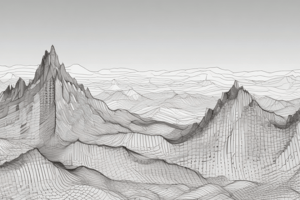Podcast
Questions and Answers
Match the following statistical methods with their definitions:
Match the following statistical methods with their definitions:
Correlation Analysis = Measures the strength and direction of a relationship between two continuous variables. Regression Techniques = Used to predict the value of a dependent variable based on the value of one or more independent variables. Quantitative Research = Involves collecting numerical data that can be quantified and analyzed statistically. Qualitative Research = Focuses on understanding concepts, thoughts, or experiences through non-numerical data.
Match the following correlation coefficients with their meanings:
Match the following correlation coefficients with their meanings:
Pearson's r = 1 = Perfect positive correlation. Pearson's r = -1 = Perfect negative correlation. Pearson's r = 0 = No correlation. Pearson's r = 0.5 = Moderate positive correlation.
Match the types of data analysis with their characteristics:
Match the types of data analysis with their characteristics:
Descriptive Statistics = Summarizes and describes the features of a dataset. Inferential Statistics = Makes inferences about a population based on a sample. Exploratory Data Analysis = Uses visual and quantitative methods to explore data. Predictive Analysis = Uses historical data to predict future outcomes.
Match the steps of performing data analysis using correlation with their descriptions:
Match the steps of performing data analysis using correlation with their descriptions:
Match the following terms with their examples:
Match the following terms with their examples:
Match the following types of correlation with their descriptions:
Match the following types of correlation with their descriptions:
Match the statistical software actions with their purposes:
Match the statistical software actions with their purposes:
Match the following data patterns with their identifiers:
Match the following data patterns with their identifiers:
Match the statistical methods with their primary purpose:
Match the statistical methods with their primary purpose:
Match the types of research with their characteristics:
Match the types of research with their characteristics:
Match the data pattern identification techniques with their definitions:
Match the data pattern identification techniques with their definitions:
Match the concepts with their explanations:
Match the concepts with their explanations:
Match the analysis techniques with their specific applications:
Match the analysis techniques with their specific applications:
Match the analysis types with their focus areas:
Match the analysis types with their focus areas:
Match the primary focus of decision-making with analytical approaches:
Match the primary focus of decision-making with analytical approaches:
Match the statistical outcomes with their implications:
Match the statistical outcomes with their implications:
Match the following statistical methods with their descriptions:
Match the following statistical methods with their descriptions:
Match the following terms with their definitions:
Match the following terms with their definitions:
Match the following correlation types with their characteristics:
Match the following correlation types with their characteristics:
Match the following regression techniques with their purposes:
Match the following regression techniques with their purposes:
Match the following concepts with their applications:
Match the following concepts with their applications:
Match the following research approaches with their characteristics:
Match the following research approaches with their characteristics:
Match the following terms related to data analysis with their meanings:
Match the following terms related to data analysis with their meanings:
Match the following tools used in data analysis with their functions:
Match the following tools used in data analysis with their functions:
Flashcards are hidden until you start studying
Study Notes
Data Analysis Overview
- Data analysis entails cleaning, transforming, and modeling data to extract useful information for decision-making.
- The primary goal is to gain insights to make informed decisions, solve problems, and improve outcomes.
- Statistical and computational methods are employed to identify non-obvious patterns and trends in data.
Performing Data Analysis Using Correlation
- Correlation analysis measures the strength and direction of relationships between continuous variables.
- An example scenario includes analyzing the relationship between hours studied and exam scores from a sample of 20 students.
- Pearson's correlation coefficient is a standard metric used for this type of analysis, often computed using statistical software or calculators.
Statistical Analysis Fundamentals
- Statistical analysis investigates trends, patterns, and relationships, relying on quantitative data.
- It is rooted in statistical principles and methods, often associated with quantitative research techniques.
Correlation vs. Regression
- Correlation and regression are statistical techniques beneficial for uncovering data patterns and relationships.
- While correlation assesses the strength between two variables, regression typically helps in predicting future outcomes based on these relationships.
Learning Objectives
- Define the terms: statistical analysis, correlation, and regression analysis.
- Differentiate between correlation analysis and regression analysis.
- Perform data analysis using both correlation and regression techniques effectively.
Importance of Data Patterns
- Identifying correlations and trends in data allows for insights into variable relationships and potential future behaviors.
- Statistical methods enrich decision-making processes, providing a framework for evaluating past experiences or predictions about the future.
Studying That Suits You
Use AI to generate personalized quizzes and flashcards to suit your learning preferences.




